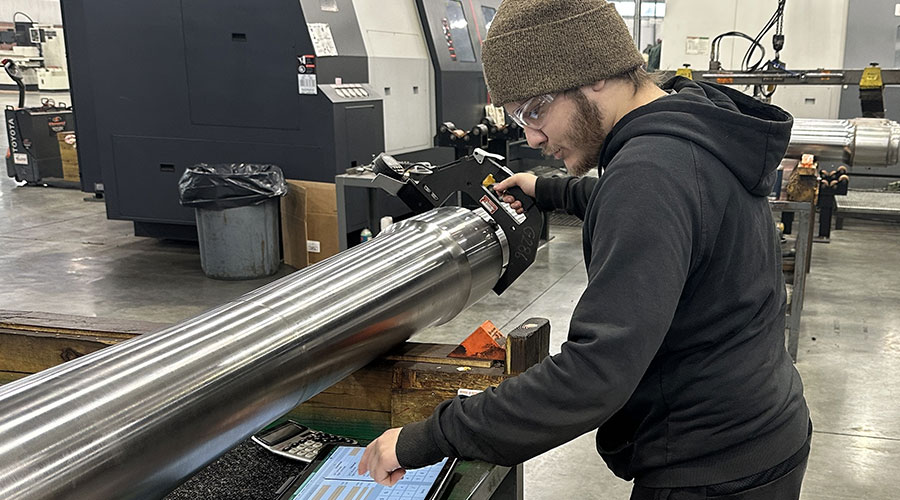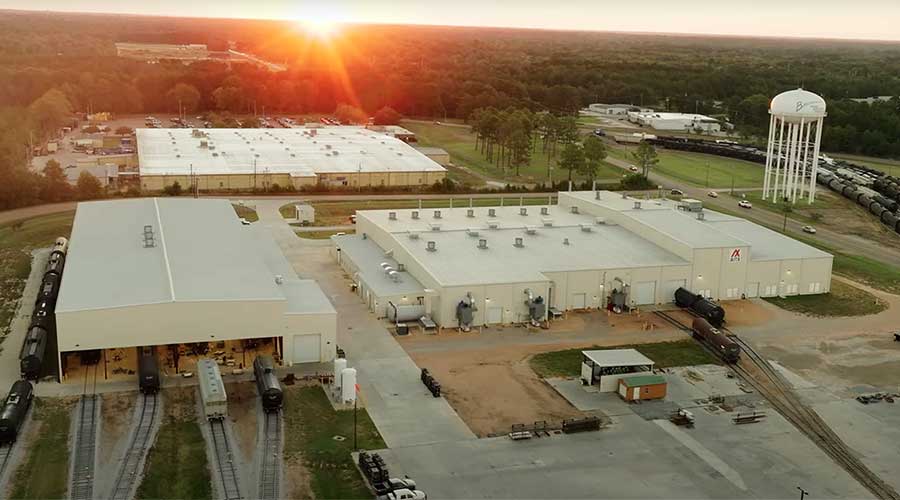Stay updated on news, articles and information for the rail industry
August 2006
Rail News: Mechanical
Wheel and bearing suppliers pump up production while developing longer-lasting products
For the past few years, it’s been an uphill ride. There’s been a constant stream of orders for new freight cars, with annual deliveries reaching the 60,000-plus mark. The skyrocketing demand coupled with raw material shortages have left many suppliers scrambling to produce enough components to meet demand.
“It’s become very difficult in the supply market to have and hold excess capacity to satisfy these peak-demand years,” says John Oliver, vice president of technical services for Amsted Rail subsidiary Griffin Wheel Co.
To meet demand, Griffin Wheel, for one, has consolidated its product offerings to focus on four basic freight-car and two locomotive wheel sizes.
“By doing that, you can improve the ability to meet demand,” says Oliver.
The company is producing 28-inch wheels for low-deck cars; 33-inch wheels for 70-ton capacity cars; 36-inch wheels for 100-ton capacity cars; 38-inch wheels for 125-ton capacity cars; and 40- and 42-inch wheels for diesel locomotives.
Focus on a few
Griffin Wheel has improved its wheel designs over the years to the point where “failure rates are very low,” says Oliver, who at this point doesn’t see a big push for even longer-lasting, lower-maintenance wheels.
That’s not to say railroads and car owners won’t want them in the future. If they do, Griffin Wheel will be ready. The company currently is developing an alloy wheel, which officials believe will last longer, and shell or spall less compared with standard wheels. Griffin Wheel has produced “a couple” of different alloy wheels and field tested one version that performed well, says Oliver. Now, the company has to determine if car owners would be willing to pay a premium price for a longer-lasting wheel.
“Alloy wheels are expensive and can be very difficult to sell in the marketplace,” says Oliver.
In the meantime, the company plans to continue improving the operating performance of its truck components, including bearings. Griffin parent Amsted Rail also owns freight-car energy management system manufacturer ASF-Keystone Inc. and bearing supplier Brenco Inc., which enables Amsted to provide complete truck systems.
Since 2004, Amsted has offered a truck system that meets M-976 specifications, which were established in 2003 by the Association of American Railroads (AAR) to raise performance standards for truck systems installed on 286,000-pound cars. Amsted’s M-976-compliant truck system comes standard with Griffin’s curved plate Class C wheels, ASF-Keystone’s AdapterPlus™ bearing adapters and Brenco’s Class K bearings.
The compact Class K bearings feature shorter components compared with standard bearings. And because they can support the heavier weight of 286,000-pound cars with less axle deflection, the bearings are becoming today’s industry standard. Brenco continues to refine and test its Class K bearing to maximize retention, reduce wear and fuel consumption and last longer.
“We’re looking at different systems to improve retention, wear and fuel consumption, and useful life,” says Amsted Vice President of Engineering Jay Monaco. “We’re also looking at various greases and lubricants, and testing different finishes and coatings.”
One recent enhancement: the Thin Gap™ seal, which reduces rolling resistance and, therefore, the amount of energy a bearing consumes during operation, says Dave Shannon, Brenco’s manager of product and performance engineering.
Supporting the loads
The Timken Co.’s version of the Class K bearing is the AP-2™, which the company developed and introduced in the mid-1990s to support heavier loads and higher speeds. Featuring a short journal, the bearing runs at lower operating temperatures and torque, and comes standard with Timken’s HDL™ seal, which provides protection against water and contaminants that can enter the bearing cavity.
Timken, which manufactures its own alloy steel, spends about $50 million annually on bearing and steel research, says Global Manager James Callan. It was that research that prompted Timken to develop the SureFit™ Universal Backing Ring, which provides an interference fit between the axle dust guard diameter and backing ring to reduce the potential for a backing ring to loosen in service.
“The North American freight industry is spending upwards of $60 million a year on loose backing rings,” says Rudy Karich, Timken’s vice president of sales and marketing-North America. “This is a low-cost solution that just incorporates into the bearing.”
Timken received conditional AAR approval for the SureFit earlier this year and expects to receive full approval by year end. The backing ring currently is being tested by several railroads and utilities. The SureFit, as well as future new products, are being developed to improve railroad operating efficiency and velocity, according to Timken.
The company also continues to market the Guardian™ bearing, which was introduced four years ago and features sensors that can transmit bearing temperature and vibration data to an onboard receiver. It’s currently being tested in revenue coal service. And the Timken-developed Generator bearing — which is designed to generate power while in operation — is currently being used to power onboard monitoring systems being tested by the Transportation Technology Center Inc. in Pueblo, Colo.
Not your conventional cage
At SKF, the most recently developed bearing product is the Universal Polymer Cage, which has a longer life expectancy and better grease distribution compared with a conventional steel cage within a tapered roller bearing, says Vice President of Marketing Greg Gerardi.
Polymer cages have been on the market for about 15 years, but SKF’s new version — which received AAR approval last year — is compatible with multiple manufacturers’ brands, says Gerardi. Most large roads have tested the product and several large utilities are using it on their rail cars. The cage now comes standard on all of SKF’s tapered bearing units, which the company offers in sizes ranging from Class C to Class G.
SKF aims to offer more compact bearings, as well. The company introduced its version of the Class K bearing in 2001, and is developing a compact Class G bearing, for which SKF expects to obtain AAR approval next year.
And while the company has been hard-pressed to keep up with freight-car component demand — SKF was in a “sell-out situation” in mid-2005, says Gerardi — it’s also taking advantage of the peak-demand period. SKF has been analyzing ways to improve production capacity at plants. The high demand also has “re-inspired” the company’s development process, says Gerardi.
“We’re taking a look at additional bearing sizes or types we haven’t traditionally manufactured,” he says.
Hence, the compact Class G bearing. SKF also is looking into providing a Class GG locomotive bearing it hasn’t manufactured in years.
“When you don’t have a lot of business, it isn’t necessarily cost effective to manufacture lower-demand products,” says Gerardi. “Now, it is.” 
Keywords
Browse articles on rail bearings rail wheel Griffin Wheel Amsted Timken SKFContact Progressive Railroading editorial staff.


 LRW Honors Amtrak’s Acheson As Railway Woman Of The Year
LRW Honors Amtrak’s Acheson As Railway Woman Of The Year
 From Editor-In-Chief Foran: Of Gender Equity And Inclusion
From Editor-In-Chief Foran: Of Gender Equity And Inclusion
 Spotlight On Some Of Today’s Rail Safety Products
Spotlight On Some Of Today’s Rail Safety Products
 Women of Influence in Rail eBook
Women of Influence in Rail eBook
 railPrime
railPrime







